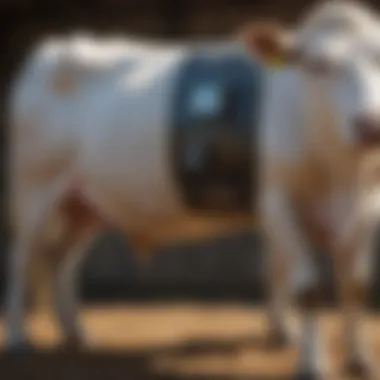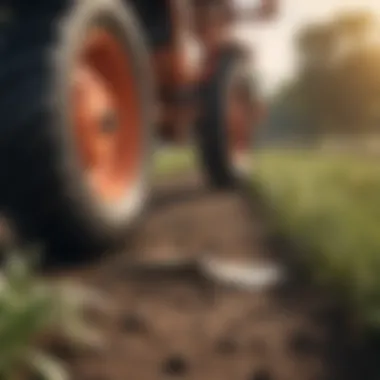Allflex Tagger Parts: Functions and Importance in Livestock


Intro
In the realm of livestock management, efficient identification and tracking of animals is essential. Allflex taggers serve as a critical tool in this regard. These taggers enhance traceability and data collection, ensuring livestock can be monitored effectively. Understanding the components that make up Allflex taggers is important for farmers and agricultural professionals. This guide aims to provide clarity on these parts, their functions, and their significance in livestock management.
Topic Overview
Definition of Key Terms
Before delving into the specifics, it is vital to understand some key terms related to Allflex taggers.
- Tagger: A device used to apply identification tags to livestock.
- Traceability: The ability to track the history, distribution, and location of livestock throughout the supply chain.
- Data Collection: The process of gathering information to assist in management decisions.
Relevance in Agriculture, Horticulture, and Agronomy
The role of Allflex taggers extends beyond simple identification. They contribute to more informed decision-making in livestock management. By enhancing traceability, farmers can track the health and breeding patterns of their animals. This is particularly important in large-scale operations where monitoring each individual animal can be challenging. Additionally, implementing tagging systems allows for better data collection, essential for optimizing farming practices and improving productivity.
Current Trends and Innovations
Recent Advancements in the Field
Allflex has been at the forefront of innovations in livestock management. Recent advancements include the integration of smart technology into tagging systems. These smart tags not only identify animals but also collect and transmit data about their health and location. This enhances the ability of farmers to make real-time decisions based on the condition and movements of their livestock.
Emerging Technologies and Practices
The introduction of electronic tags is another significant trend. These tags allow farmers to utilize scanning devices that can quickly retrieve important data related to each animal. Such technologies streamline the management process and reduce manual labor. Moreover, these advancements support the agricultural sector's move towards more sustainable practices by providing precise data that can help in resource allocation.
Practical Applications
Step-by-Step Guides or How-Tos
- Selecting the Appropriate Tagger for Your Needs: Consider the type of livestock and the specific needs of your farm.
- Preparing to Apply Tags: Ensure you have all necessary equipment ready, including disinfectant, gloves, and the tagger itself.
- Tag Application: Follow the manufacturer's instructions carefully to apply tags without causing harm to the animal.
- Data Entry: Immediately after tagging, input the identification information into your management system for record-keeping.
Tips and Best Practices for Implementation
- Always wear gloves to maintain hygiene while tagging.
- Ensure you do not overcrowd the animals during tagging, as this can cause stress.
- Regularly monitor and maintain taggers for optimal performance.
- Train staff on proper tagging techniques to ensure consistency and effectiveness.
"Proper management of livestock through effective tagging systems results in better health, productivity, and overall farm management."
Preamble to Allflex Tagger Systems
The Allflex tagger systems play a crucial role in modern livestock management. They provide essential means of tracking, monitoring, and managing animals within a farm setting. In this context, understanding the Allflex tagger systems is fundamental for agricultural professionals who seek to optimize their operations through effective animal identification.
Efficient livestock management revolves around accurate data collection and traceability. Allflex taggers are designed to facilitate this process, providing reliable and durable identification solutions for livestock. These systems not only enhance the accuracy of data recorded but also contribute significantly to animal welfare by ensuring timely interventions when necessary.
Overview of Tagging in Livestock Management
Tagging in livestock management serves several pivotal functions. It allows farmers to monitor individual animal performance, track health records, and manage breeding programs effectively. Proper tagging ensures each animal can be identified quickly, reducing risks associated with mismanagement.
With the advancement in tagging technologies, farmers can now access real-time data. This helps in better decision-making. For instance, knowing the reproductive cycle of an animal can optimize breeding schedules and improve herd quality.
Purpose and Importance of Allflex Taggers
The purpose of Allflex taggers extends well beyond mere identification of animals. They are integrated into a larger ecosystem of livestock management tools. These taggers facilitate data recording related to health, production, and origin. Thus, they support farmers in their efforts to enhance productivity and efficiency in their operations.
Key benefits of Allflex taggers include:
- Enhanced Traceability: Each tag contains specific information that aids in tracking livestock throughout their lifecycle.
- Improved Data Accuracy: Automatic data collection minimizes human error and provides a clear record of animal health.
- Integration with Technology: Allflex taggers can connect with software and apps, allowing for seamless data management and analysis.
"In utilizing Allflex taggers, farmers are not just labeling their livestock; they are investing in a system that upholds operational integrity and improves overall farm management."


Components of the Allflex Tagger
The Allflex tagger is an essential tool in livestock management, facilitating not only identification but also efficient tracking of animals. Understanding the components of the Allflex tagger will help users maximize the benefits of tagging systems. Each part plays a specific role that contributes to ease of use and functionality in various farming practices.
Main Parts of the Allflex Tagger
The Allflex tagger consists of several main parts. Primarily, it features the tag applicator, which is engineered to securely attach tags to animals with minimal discomfort. The applicator is designed with a handle that allows the user to maintain a steady grip. This is crucial for effective tagging, especially in busy farm environments. Additionally, the tagging mechanism operates with a precision spring-loaded action, ensuring that tags are placed accurately.
Another key component is the tag itself, available in various sizes and colors. This variety adds flexibility for users to choose tags that suit their individual livestock management needs. Tags may also include RFID technologies for digital tracking, enhancing data collection capabilities.
Differences Between Models
Understanding the differences between Allflex tagger models can help farmers select the appropriate option for their needs.
Standard Models
Standard models of the Allflex tagger are widely used among farmers for their simplicity and reliability. A significant aspect of standard models is their ease of operation, which allows even less experienced users to apply tags effectively. Their design is robust, making them a popular choice for traditional livestock operations.
Moreover, these models often come with basic functions that meet the essential tagging needs in many agricultural settings. One of their unique features is compatibility with various tag sizes, which adds a level of versatility. However, they may lack advanced functions such as connectivity with digital systems.
Advanced Models
Advanced models of Allflex taggers offer additional features that cater to tech-savvy users. A primary characteristic of these models is the integration of digital tracking capabilities, which can significantly enhance data insights. Advanced models usually include features for real-time data exchange, allowing farmers to monitor animal health and location remotely.
This enhanced capability makes advanced models beneficial for operations that depend on data-driven decision-making. However, they can come at a higher price point. Thus, it is essential for users to weigh these benefits against their requirements and budget constraints.
"Selecting the right Allflex tagger model can dramatically impact your livestock management efficiency and data accuracy."
By understanding the components and their functions, agricultural professionals can better utilize Allflex taggers to enhance their operations.
Functional Roles of Tagger Parts
The effectiveness of Allflex taggers in livestock management hinges significantly on the functional roles of their individual parts. These components are engineered to work in harmony to ensure reliable tagging. Understanding how they function allows farmers to utilize these tools to their fullest potential. Beyond mere identification, their roles encompass critical tasks such as data recording and providing traceability. This can drastically improve management efficiency.
Understanding the Tagging Mechanism
The tagging mechanism forms the core of the Allflex tagger functionality. Each tagger is designed to apply a tag securely to an animal while minimizing discomfort. The mechanism typically consists of components like a handle, a trigger, and a tag applicator. When the trigger is pressed, the applicator delivers the tag with precision. This process needs to be seamless to ensure that livestock are tagged efficiently.
Key aspects of the tagging mechanism include:
- Ergonomics: Designed for comfort during repetitive use.
- Reliability: Ensures that tags are applied securely without harming the animal.
- Speed: Increases the pace of tagging, allowing farmers to manage larger groups more effectively.
The integration of these elements into the tagging process reduces stress for both the operator and the livestock. Understanding this mechanism is crucial for any agricultural professional who aims to maintain high well-being standards in their livestock management practices.
Data Recording and Traceability Functions
In today's agricultural landscape, data is a vital resource. Allflex taggers are not just tools for identification; they also serve as platforms for data recording and enhancing traceability. Each tag acts as a repository of essential information about the animal, such as health history, breeding details, and feeding patterns.
Important features related to data recording include:
- Information Storage: Tags can store various data points that can be accessed later.
- Integration with Software: Many Allflex systems can sync with data management software, allowing for efficient tracking.
- Traceability: Helps maintain compliance with health regulations and offers insights into herd management.
The capability to record and trace animals provides farmers with actionable insights, which can lead to better decision-making. These elements not only improve operational efficiencies but also support improved herd health and productivity.
"Effective tagging is the backbone of modern livestock management, allowing for detailed monitoring and data-driven decisions."
Overall, understanding the functional roles of Allflex tagger parts is fundamental for livestock managers aiming to optimize their operations. By leveraging these tools effectively, they can enhance both productivity and animal welfare.
Maintenance of Allflex Tagger Parts


Maintenance is a crucial aspect of ensuring that Allflex taggers operate effectively and efficiently. Regular upkeep not only prolongs the lifespan of the equipment but also guarantees accuracy in tagging, which is vital for livestock management. Neglecting maintenance can lead to malfunctions that complicate data collection efforts and can cause disruptions in operations. Adhering to maintenance guidelines can prevent costly repairs down the line and maintain the integrity of data records.
Routine Care Requirements
Routine care for Allflex taggers involves several steps that can significantly enhance their performance. Farmers should establish a regular cleaning schedule, particularly for parts that come in direct contact with animals. Here are some essential care requirements:
- Clean the Tagging Head: After each use, the tagging head should be cleaned with a mild disinfectant to prevent the spread of infections among livestock.
- Inspect for Wear: Regularly check the condition of the clips and pins. Any signs of wear or damage can affect the tagging process and need prompt attention.
- Lubricate Moving Parts: It is essential to apply a suitable lubricant to the moving parts intermittently. This prevents friction and allows smooth operation.
- Store Properly: After use, Allflex taggers should be stored in a cool, dry place to avoid environmental wear. Exposure to moisture or extreme temperatures can lead to deterioration of parts.
Implementing these routine care strategies can lead to improved operational efficiency and ensure the taggers are always ready for use.
Repairing and Replacing Parts
Eventually, some parts of the Allflex tagger will require repairing or replacing. Understanding the process can help farmers act swiftly when issues are identified. Here are key considerations when dealing with repairs:
- Identify the Problem: Before any repairs, accurately diagnosing the issue is essential. Look for signs like irregular tagging incidents, ineffective data collection, and mechanical sounds during operation.
- Use Genuine Spare Parts: When replacing parts, always opt for genuine Allflex components. This ensures compatibility and maintains the tagger's performance attributes.
- Emergency Repairs: Have a basic repair kit that includes essential tools and spare parts handy. Quick repairs can minimize downtimes during peak tagging seasons.
- Consult Professionals: For complex issues, engaging a professional for maintenance might be warranted. Their expertise can save you time and prevent further damage to the tagger.
By prioritizing routine care and being vigilant about repairs, farmers can sustain the efficiency of their Allflex taggers and continue to benefit from these precision tools in their operations.
Advancements in Allflex Tagger Technology
Advancements in Allflex Tagger Technology note a significant evolution in livestock management systems. These improvements give farmers better data collection, efficient operations, and enhanced animal welfare monitoring. As technology progresses, it becomes vital for agricultural professionals to understand these advancements to improve their livestock management practices.
Integration of Digital Technologies
The integration of digital technologies into tagger systems has transformed animal tracking and monitoring. Digital features allow seamless connectivity between taggers and data management systems. Through mobile applications, farmers can access data from anywhere, improving real-time decision-making. Such integration simplifies tasks such as herd monitoring, health checks, and traceability. Overall, this advancement ensures that farmers can handle their livestock more effectively and efficiently.
Future Trends in Tagging Systems
Smart Tags
Smart tags represent a notable achievement in livestock management. The key characteristic of smart tags is their ability to collect and transmit data wirelessly. Their unique feature includes GPS tracking, which enhances real-time location monitoring. Smart tags improve operational efficiency and animal welfare. However, some farmers may face challenges with connectivity in remote areas, which can limit the effectiveness of this technology. Balancing the advantages and disadvantages of smart tags ensures informed decisions about adopting new systems.
Cloud Integration
Cloud integration is a significant aspect of modern tagging systems, enabling centralized data management. The key feature includes the ability to store and analyze data from multiple sources. This allows for comprehensive insights into herds. Cloud integration also enables additional analytics, providing farmers with data-driven recommendations. Nonetheless, reliance on cloud services can pose security and data privacy concerns for farmers. It is essential to consider these factors when adopting cloud technologies.
The future of tagging systems is leaning towards increased connectivity and smarter solutions, which promises to enhance livestock management efficiency.
In summary, advancements in Allflex tagger technology underscore the importance of integrating digital solutions. The shift towards smart tags and cloud integration presents both opportunities and challenges. As livestock management continues to evolve, understanding these elements will help farmers optimize their operations and improve the well-being of their animals.
Comparative Analysis with Other Tagging Systems
In today’s competitive landscape of livestock management, the choice of tagging system can significantly impact operational efficiency and animal health management. A comparative analysis of Allflex taggers with various competitor systems unveils their unique benefits and considerations. Understanding these differences allows agricultural professionals to make informed decisions based on their specific needs, productivity goals, and operational scale.
Allflex vs. Competitor Systems
Allflex taggers are known for their reliability and advanced features. When comparing Allflex to competitor systems like Datamars, Z tags, and Hayshaker, several factors come into play:
- Technology: Allflex integrates digital technologies, enabling efficient data recording and retrieval. Competitor systems may lack such sophisticated digital interfaces.
- User Experience: The ergonomics of Allflex taggers are often highlighted by users as more comfortable and intuitive, which reduces fatigue during prolonged use.
- Durability: Allflex products tend to withstand harsh environmental conditions better than some alternatives, ensuring longer life and less frequent replacements.
One vital aspect for consideration is the support and service provided by manufacturers. Allflex often features robust customer support compared to some mid-range brands. This includes assistance with installation and maintenance, which can influence overall satisfaction and performance.
Choosing the Right System for Your Needs
Selecting the appropriate tagging system is paramount for any livestock operation, be it a small farm or large-scale ranch. Several criteria can help streamline this decision:
- Animal Type: Different tagging systems cater to various species. Ensure the selected system meets the specifications required for the type of livestock you manage.
- Features Needed: Consider what functionalities are critical for your operations. For example, if animal tracking and health monitoring are priorities, systems with advanced data integration like Allflex may be essential.
- Budget Constraints: Pricing can vary significantly between systems. While Allflex may represent a higher upfront cost, the durability and features may justify the investment over time.
- Future Scalability: Choose a system that can evolve with your operations. With advancements in technology, a system like Allflex often offers more flexibility for future requirements than basic competitor brands.
"Investing in the right tagging system spares farmers troubleshooting headaches and enhances data accuracy, leading to better herd management."


Ultimately, the best choice depends on individual farm goals and preferences. Thoroughly evaluate available options, examine user feedback, and possibly consult with other farmers for firsthand insights to inform your decision.
Practical Applications of Allflex Taggers
The Allflex tagger systems provide vital support in various practical applications within livestock management. Their ability to facilitate tracking, monitoring, and analyzing animal behavior and health has transformed traditional practices. The importance of Allflex taggers lies not only in their functionality but also in the significant benefits they offer to farmers and agricultural enthusiasts. Understanding how these taggers can be applied encompasses aspects such as increased efficiency, streamlined operations, and enhanced data collection.
Use in Cattle Management
Cattle management represents one of the primary areas where Allflex taggers are indispensable. By tagging cattle, farmers gain a clear method for monitoring individual animals. Each tag stores essential data which can signal information about the animal's age, breeding history, and vaccination records. Moreover, all this data can be synced with various management software systems, simplifying record operations.
This technology supports timely decision-making. For example, if data reveals that an animal is not gaining weight as expected, farmers can quickly investigate possible health issues or dietary deficiencies. Furthermore, Allflex taggers can provide geographical tracking through GPS functionalities. Such features improve grazing management significantly, as farmers can analyze pasture use and prevent overgrazing by ensuring that cattle move to appropriate areas.
Benefits of using taggers in cattle management include:
- Improved tracking and tracing of animals
- Efficient record-keeping with easy access
- Enhanced health monitoring through real-time data
Tagging for Health Monitoring
Health monitoring is another critical aspect of Allflex taggers. These systems include advanced features that allow farmers to monitor the well-being of their livestock effectively. Each tag can transmit data related to vital signs, such as heart rate and activity levels. This continuous monitoring enables early detection of illnesses or stress in animals. With accurate health data, farmers can take swift actions, thus mitigating risk of more widespread health issues.
The tags may also include temperature sensors, alerting farmers to potential fever signs before the animal shows obvious symptoms. This proactive approach enhances animal welfare and can result in lower vet costs. In times of disease outbreaks, prompt action based on tagging data can prevent losses and sustain herd health.
Some considerations regarding health monitoring using Allflex taggers:
- Quick identification of sick animals
- Reduction of labor through automation of monitoring tasks
- Better overall herd management resulting from health insights
"Integrating Allflex taggers into livestock management systems fosters a proactive approach to maintaining health and productivity in animals."
In summary, the practical applications of Allflex taggers in cattle management and health monitoring illustrate their essential roles in modern agricultural practices. These systems not only promote efficiency but also significantly contribute to the overall health and productivity of livestock, marking them as crucial tools in a farmer's arsenal.
Case Studies and Success Stories
Case studies serve a pivotal role in this article as they exemplify the real-world applications and successes of Allflex taggers. Through these practical examples, we can illustrate how these tagging systems enhance operational efficiency, data collection, and overall livestock management. This section provides not only insight into the transformative power of these tools but also offers a basis for persuasive arguments that appeal to skeptical stakeholders in agriculture.
Successful Implementations in Livestock Farms
Several farms have successfully implemented Allflex taggers, demonstrating their unique functionalities. For instance, a dairy farm in Wisconsin integrated Allflex tagging systems to monitor the health of their herd. By using these tags, farm managers could easily identify individual cows and track their reproductive cycles and health records. The data gained from these tags facilitated timely interventions when health issues arose, showcasing a significant reduction in veterinary costs.
Another notable application was observed in beef cattle operations. A ranch in Texas reported efficiency gains after employing Allflex systems to enhance their cattle identification processes. With each animal tagged, they could swiftly gather the information regarding feed efficiency and weight gain, leading to better management decisions.
These implementations underline the advantages that Allflex taggers provide. Many farms found increased transparency and improvements in tracking livestock history, which are critical for breeding and health monitoring.
Impact on Operational Efficiency
The implementation of Allflex taggers has shown measurable impact on operational efficiency in livestock production. Farms that have adopted these systems report streamlined processes that save time and resources.
- Labor Efficiency: Taggers reduce the amount of manual labor required for tracking livestock. Less staff time spent on tracking means more time can be allocated for other essential activities on the farm.
- Data Accuracy: With digital tagging, records are less prone to human error. This accuracy is essential for maintaining precise health and tracking data, which influences farm management decisions.
- Time Savings: Allflex taggers allow for immediate data collection and access. This rapid information flow leads to quicker decision-making, optimizing responses to issues such as health outbreaks or productivity declines.
"The most significant change has been in our daily operations. With Allflex tags, we could focus on proactive management rather than reactive responses to problems," stated a farm manager from Nebraska.
End on the Role of Allflex Taggers
The Allflex taggers play a significant role in modern livestock management. Their ability to enhance tracing and data collection is invaluable. As livestock farming becomes more data-driven, the importance of these tools increases. Allflex taggers allow farmers to monitor herd health, track animal movements, and manage breeding and feeding practices efficiently. Thus, they contribute to improved farm management and can directly impact profitability.
Summary of Key Points
- Integration in Livestock Management: Allflex taggers are integral in facilitating effective livestock management. They provide critical data that assists farmers in making informed decisions.
- Components Functionality: Understanding the parts of the tagger helps farmers appreciate its operational efficiency. Through components designed for specific functions, the tagging system operates seamlessly.
- Maintenance Importance: Regular maintenance ensures the longevity of the taggers. This aspect is often overlooked but is crucial for optimal performance.
- Advancements in Technology: The incorporation of digital technology signifies a leap forward in tagging systems, with features like cloud integration improving data accessibility and analysis.
Addressing Future Challenges
While Allflex taggers offer numerous benefits, challenges do exist.
- Adoption of Technology: Not all farmers are familiar with digital technologies. Training and support will be essential for effective implementation.
- Data Management: As data collection increases, so does the complexity of managing that data. Farmers may need to invest in data management solutions.
- Cost Considerations: Although Allflex taggers provide long-term savings, the initial investment can be a barrier for some farmers. Understanding the return on investment is critical for decision-making.
By addressing these challenges, farmers can fully harness the benefits that Allflex taggers provide, leading to enhanced efficiency in livestock management.



